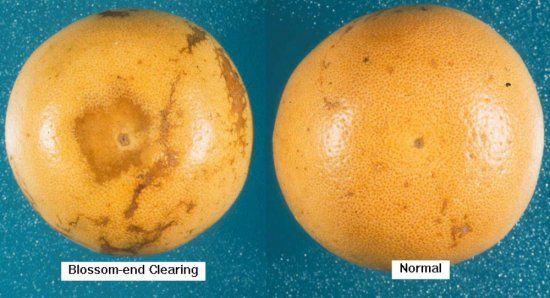Symptoms
Blossom-end clearing (BEC) is characterized by the translucent, watersoaked appearance of the fruit peel (most commonly at the blossom end) caused by internal bruising and juice leakage from juice vesicles (Figure 1 and Figure 2). Juice vesicles in the bruised areas usually have a gray tinge compared with unbruised tissue, and BEC-affected fruit develop off flavors. BEC is visible within 24 hours after bruising (often much earlier) and can affect up to 90% of the fruit in some loads. Decay, in particular mold, often develops in areas with BEC symptoms. BEC has also been referred as "wet bottoms," "stylar-end clearing," "water bottom," "waterlog," and "wet wick."


Factors Involved in BEC Development
Fruit Characteristics
Seedless grapefruit (e.g. 'Ruby Red' or 'Marsh') are most affected by BEC. The disorder is similar in appearance to "stylar end breakdown" or "juice spot" of 'Tahiti' limes. Grapefruit grown along Floridas east coast (Indian River region) are more prone to BEC development than fruit grown in the state's central regions. BEC develops most often in late-season fruit. Depending on the year, greater susceptibility to BEC may begin to appear in January and increase rapidly throughout the remainder of the harvest season. During this time, incidence in fruit from the same grove may increase about 4 fold. Sensitive fruit often exhibit an open core with little spongy tissue and juice vesicles that protrude into the cavity. The fragile vesicle membranes rupture easily and leak juice into the core. The juice eventually runs into the peel at the blossom end of the fruit creating a wet spot. Small fruit may be twice as likely to develop BEC than large fruit. Thicker-skinned fruit develop less BEC than thin-skinned fruit under the same conditions. The severity of BEC varies widely from year to year and from grove to grove.
Rough Handling
BEC almost never occurs while fruit are still attached to the tree and does not develop on fruit handled very gently (receiving no drops or appreciable surface impacts). Rough handling is the primary cause of fruit BEC. Though fruit handling during harvest (e.g. from dumping fruit into bins) may cause BEC, most BEC develops as a result of rough handling in the packinghouse. Dumping operations are most likely to produce impacts that cause BEC, but other steps in the packing operation (e.g. presizer, sizing, and bagging/packing) can also contribute to BEC. Efforts should be taken to minimize drop heights and other impacts throughout the packing operation. For example, reducing fruit drop heights from 2 feet to 1 foot can reduce the development of BEC by more than half. Refer to Miller et al. (2001) for more information on reducing fruit damage in citrus packinghouses (http://ufdc.ufl.edu/IR00003717/00001).
Temperature & RH
Although damage from rough handling is necessary to cause BEC, other postharvest factors also influence its development. Incidence of BEC greatly increases with higher fruit temperatures; doubling the fruit temperature can more than double the likelihood of BEC development. Thus, harvesting fruit earlier in the morning when fruit temperatures are cooler will reduce the incidence of BEC. Even if fruit were exposed to high temperatures in the grove prior to harvest, cooling the fruit (e.g. even to 70°F) will dramatically reduce the likelihood of developing BEC during packing operations. Such cooling is especially important later in the season when fruit are most likely to develop BEC. Holding fruit at low humidities prior to packing increases fruit susceptibility to BEC compared to holding it at high humidities. For example, fruit held for 2 days at 40% RH before packing developed about twice as much BEC as fruit held for 2 days at 95% RH at the same temperature. It is thought that cultural practices also influence fruit susceptibility to BEC, but there is no data at present.
Recommendations to Reduce BEC
- Carefully handle grapefruit during all harvesting and packing operations.
- Groves with a history of BEC should be harvested no later than early March.
- Harvest fruit earlier in the morning when fruit temperatures are lower. Be cautious, however, that fruit are not so turgid that oil spotting (oleocellosis) results.
- Allow susceptible fruit harvested under warm conditions to cool overnight (e.g. to 70°F or below) before packing.
- Always hold fruit under high relative humidities.
Selected References
Echeverria, E. and J.K. Burns. 1994. Handling and Storage Conditions that Affect Blossom End Clearing Development in Grapefruit. Proc. Fla. State. Hort. Soc. 107:243–245.
Echeverria, E., J.K. Burns, and W.M. Miller. 1999. Fruit Temperature and Maturity Affect Development of Blossom End Clearing in Grapefruit. HortScience 34:1249–1250.
McCornack, A. A. 1966. Blossom End Clearing of Grapefruit. Proc. Fla. State. Hort. Soc. 79:258–264.
Miller, W.M., W.F. Wardowski, and W. Grierson. 2001. Packingline Machinery for Florida Citrus Packinghouses. Bull. 239. Gainesville: University of Florida Institute of Food and Agricultural Sciences. (http://ufdc.ufl.edu/IR00003717/00001)